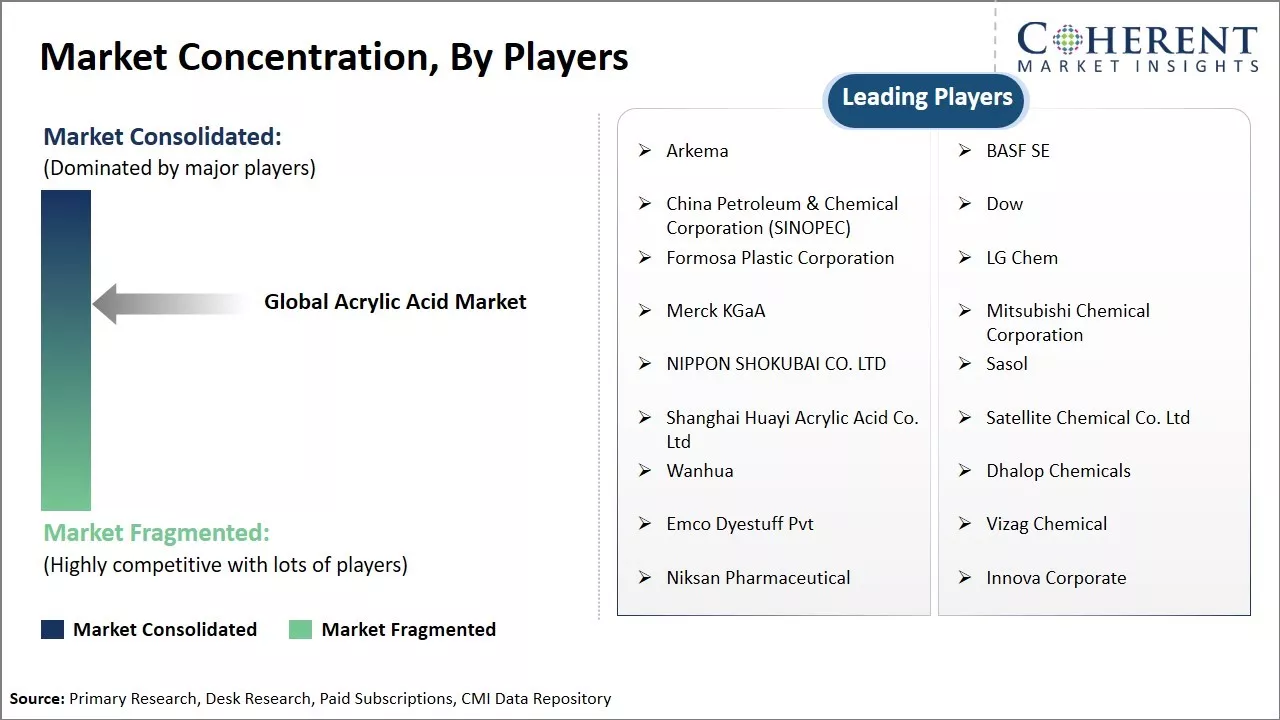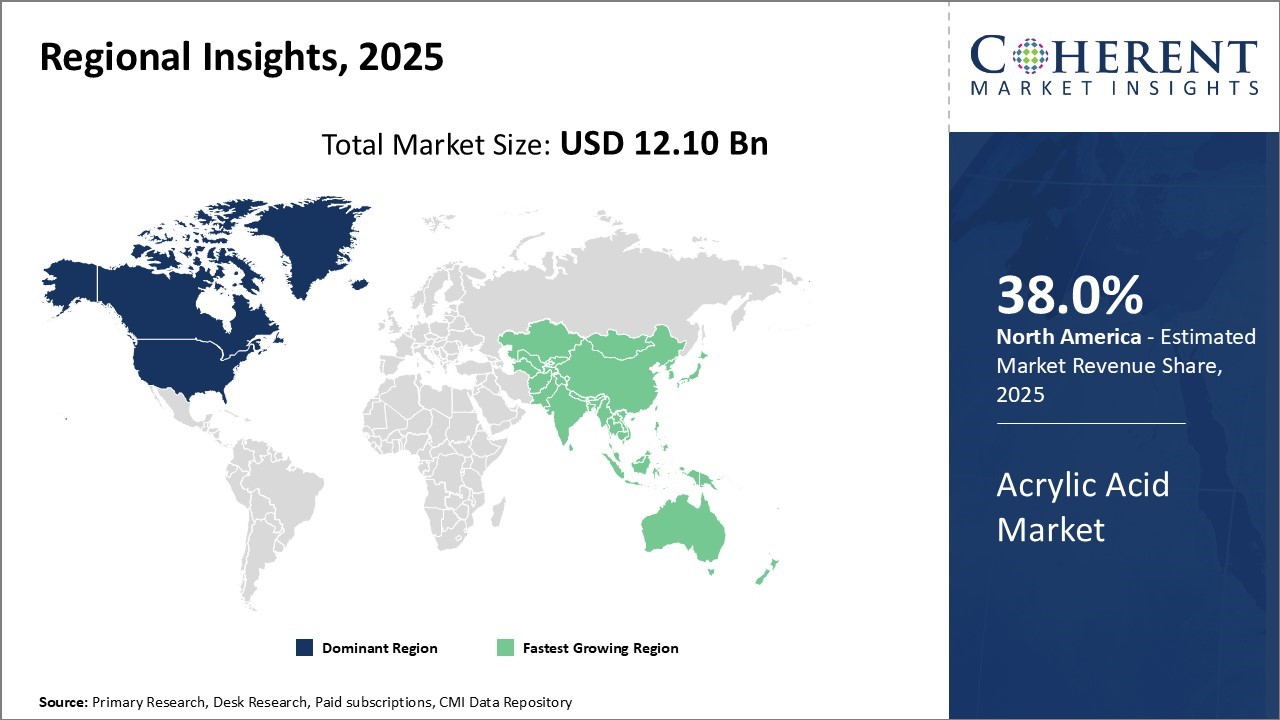The global acrylic acid market is estimated to be valued at USD 12.10 Bn in 2025 and is expected to reach USD 15.51 Bn by 2032, growing at a compound annual growth rate (CAGR) of 3.6% from 2025 to 2032.

To learn more about this report, Download Free Sample
Acrylic acid is used as a raw material for various products like superabsorbent polymers, acrylate esters, acrylamide, and others which find applications in industries like construction, packaging, and hygiene among others which is fueling the market growth. The market is expected to witness steady growth on account of rising application of acrylic acid in the production of water absorbent polymers which are majorly used in baby diapers. Adult incontinence products and female hygiene products. With rising global population and consumption, the demand for such end-use products is growing, which will drive the acrylic acid market during the forecast period.
|
Current Events |
Description and its impact |
|
Increase of Acrylic Acid Production Capacity in Asia |
|
|
Bio-Based Acrylic Acid Production Expansion |
|
Uncover macros and micros vetted on 75+ parameters: Get instant access to report

To learn more about this report, Download Free Sample
Super absorbent polymers are primarily used in baby diapers and feminine hygiene products such as sanitary napkins with 35.0% share in 2025. The global birth rate has been steadily increasing over the past few decades, driving greater demand for baby diapers. As disposable incomes rise across developing regions, more parents are opting for convenient disposable diapers rather than traditional cloth diapers.
Additionally, women's emancipation and rising awareness about hygiene has boosted sales of Sanitary pads worldwide. Super absorbent polymers play a vital role in absorbing and retaining liquids in these single-use products. Their ability to absorb hundreds of times their own weight in fluids makes them perfectly suited for applications that require rapid liquid uptake and retention.
Furthermore, ongoing initiatives by governments and NGOs to promote menstrual hygiene in rural areas will augment the consumption of super absorbent polymers used in sanitary protection. Rapid urbanization too is resulting in changed lifestyles that favor the usage of disposable hygiene products. These structural trends in populations and lifestyles will ensure sustained demand growth for super absorbent polymers used in baby and feminine care applications over the foreseeable future.
Acrylic acid plays an indispensable role in the production of paints and coatings with 34.8% share in 2025. It is primarily used to manufacture polyacrylates - versatile binders that give paints and coatings excellent adhesion, corrosion protection, gloss, durability, and weatherability. Both architectural and industrial sectors extensively employ paints and coatings for applications such as building exteriors, vehicles, machinery, facilities, etc.
The architectural segment in particular has been growing steadily with the ongoing construction of residential and commercial infrastructure worldwide. Meanwhile, recovering industrial activity is also propelling the demand for industrial coatings from sectors like automotive, general manufacturing, oil & gas, aerospace, etc.
Acrylic acid feeds into these robust coatings market by offering properties like gloss retention, resistance to abrasion and chemicals, and compatibility with a range of pigments and solvents - making it suitable for diverse end use environments. Water-based acrylic coatings especially are gaining favor due to their low VOC emission and eco-friendly nature. Thus, the widespread applicability and growing consumption of paints and coatings across industries continues to make it the dominant end-user segment for acrylic acid globally.

To learn more about this report, Download Free Sample
North America currently dominates the global acrylic acid market and is expected to remain the leading regional market over the forecast period. It is expected to hold 38.0% of the market share in 2025. The region has a strong presence of raw material suppliers and acrylic acid manufacturers. The U.S., in particular, is home to some of the largest companies in the acrylic acid industry such as Dow Chemicals and Arkema.
The favorable business environment and easy availability of feedstock have been driving factors for industry players to focus on capacity additions.
The Asia Pacific region is poised to be the fastest growing market for acrylic acid during this decade. Rapid industrialization and infrastructure development are driving the consumption of downstream products in countries such as China and India. Both nations have emerged as global manufacturing hubs which is increasing the demand for acrylic acid in applications like superabsorbent polymers, paints, and construction chemicals. Local producers are expanding their capacity to cater to the growing needs of domestic industries.
The United States dominates the acrylic acid market due to its highly developed chemical production base and robust demand from end-use applications like adhesives, coatings, and personal care. Having large chemical majors and ongoing investments in capacity increases facilitates its dominance of the market.
Germany is also a significant player in the acrylic acid industry, thanks to high demand from the automotive and construction industries, and accelerated industrialization and urbanization. The nation has significantly invested in increasing its production capacities, making it one of the world's largest producers and consumers.
Germany leads the European market for acrylic acid with its well-developed chemical industry and high emphasis on research and development. Germany's high environmental regulations also promote the use of environmentally friendly production technologies, maintaining it as the leader in terms of innovation.
India is becoming an emerging market for acrylic acid owing to increasing manufacturing industries, growing disposable income, and greater use in hygiene products and coatings. Investments in new production facilities and technology upgradation are driving India's market share.
| Report Coverage | Details | ||
|---|---|---|---|
| Base Year: | 2024 | Market Size in 2025: | USD 12.10 Bn |
| Historical Data for: | 2020 To 2024 | Forecast Period: | 2025 To 2032 |
| Forecast Period 2025 to 2032 CAGR: | 3.6% | 2032 Value Projection: | USD 15.51 Bn |
| Geographies covered: |
|
||
| Segments covered: |
|
||
| Companies covered: |
Arkema, BASF SE, China Petroleum & Chemical Corporation (SINOPEC), Dow, Formosa Plastic Corporation, LG Chem, Merck KGaA, Mitsubishi Chemical Corporation, NIPPON SHOKUBAI CO. LTD, Sasol, Shanghai Huayi Acrylic Acid Co. Ltd, Satellite Chemical Co. Ltd, Wanhua, Dhalop Chemicals, Emco Dyestuff Pvt , Vizag Chemical, Niksan Pharmaceutical, and Innova Corporate |
||
| Growth Drivers: |
|
||
| Restraints & Challenges: |
|
||
Uncover macros and micros vetted on 75+ parameters: Get instant access to report
The super absorbent polymer industry has been a major contributor to the growth of the global acrylic acid market. Super absorbent polymers, also known as sodium polyacrylate or polyacrylate, are polymers that can absorb and retain large amounts of liquids relative to their own mass. They are primarily used in personal hygiene products like baby diapers, adult incontinence products, and feminine hygiene products.
Acrylic acid serves as the primary raw material for the production of super absorbent polymers. The global demand for super absorbent polymers has been increasing steadily owing to the rising aged population who require adult incontinence products and the growing baby population who use more disposable diapers.
The high absorbency and moisture wicking properties of super absorbent polymers provide more comfort to consumers, making disposable diapers and other hygiene products more popular. With increasing spending power, consumers in developing countries of Asia Pacific and Latin America are opting for disposable hygiene products instead of traditional cloth diapers and rags.
For example, in 2024, Arkema’s acrylic acid and ester production plant in Taixing, China received ISCC+ certification, affirming its sustainable, mass-balanced production process and reinforcing its commitment to greener chemical manufacturing.
The adhesive and sealants industry has emerged as another major driving factor for the global acrylic acid market in recent years. Acrylic acid serves as a primary monomer for the production of various types of adhesives and sealants that are used across various applications. With the growing infrastructure and construction activities, the demand for adhesives and sealants from building & construction industry has increased manifold.
Acrylic adhesives offer high strength, flexibility and resistance to heat and water, making them ideal for construction applications. Similarly, increasing automotive production is propelling the demand for acrylic sealants and adhesives that are used in vehicle manufacturing. Other applications such as packaging, footwear and furniture manufacturing also consume significant amounts of acrylic adhesives.
Strict environmental regulations regarding the use of solvent-based adhesives have further boosted the popularity of solvent-free and water-based acrylic adhesives. Large players in the adhesive and sealants industry are investing in R&D to develop newer acrylic formulations with enhanced properties.
The acrylic acid market forecast for 2025 highlights strong growth driven by rising demand from the superabsorbent polymers sector, particularly in hygiene products like diapers and adult incontinence items. Additionally, acrylic acid’s widespread use in surface coatings and adhesives is seeing increased traction from booming construction and automotive industries. These applications benefit from acrylic acid’s durability, water resistance, and bonding properties. Rapid urbanization, infrastructure development, and vehicle production in emerging economies further fuel market expansion. As industries seek high-performance materials, acrylic acid remains a critical component, positioning the market for robust growth across multiple sectors in the coming years.
Share
Share
About Author
Vidyesh Swar is a seasoned Consultant with a diverse background in market research and business consulting. With over 6 years of experience, Vidyesh has established a strong reputation for his proficiency in market estimations, supplier landscape analysis, and market share assessments for tailored research solution. Using his deep industry knowledge and analytical skills, he provides valuable insights and strategic recommendations, enabling clients to make informed decisions and navigate complex business landscapes.
Missing comfort of reading report in your local language? Find your preferred language :
Transform your Strategy with Exclusive Trending Reports :
Frequently Asked Questions
Joining thousands of companies around the world committed to making the Excellent Business Solutions.
View All Our Clients